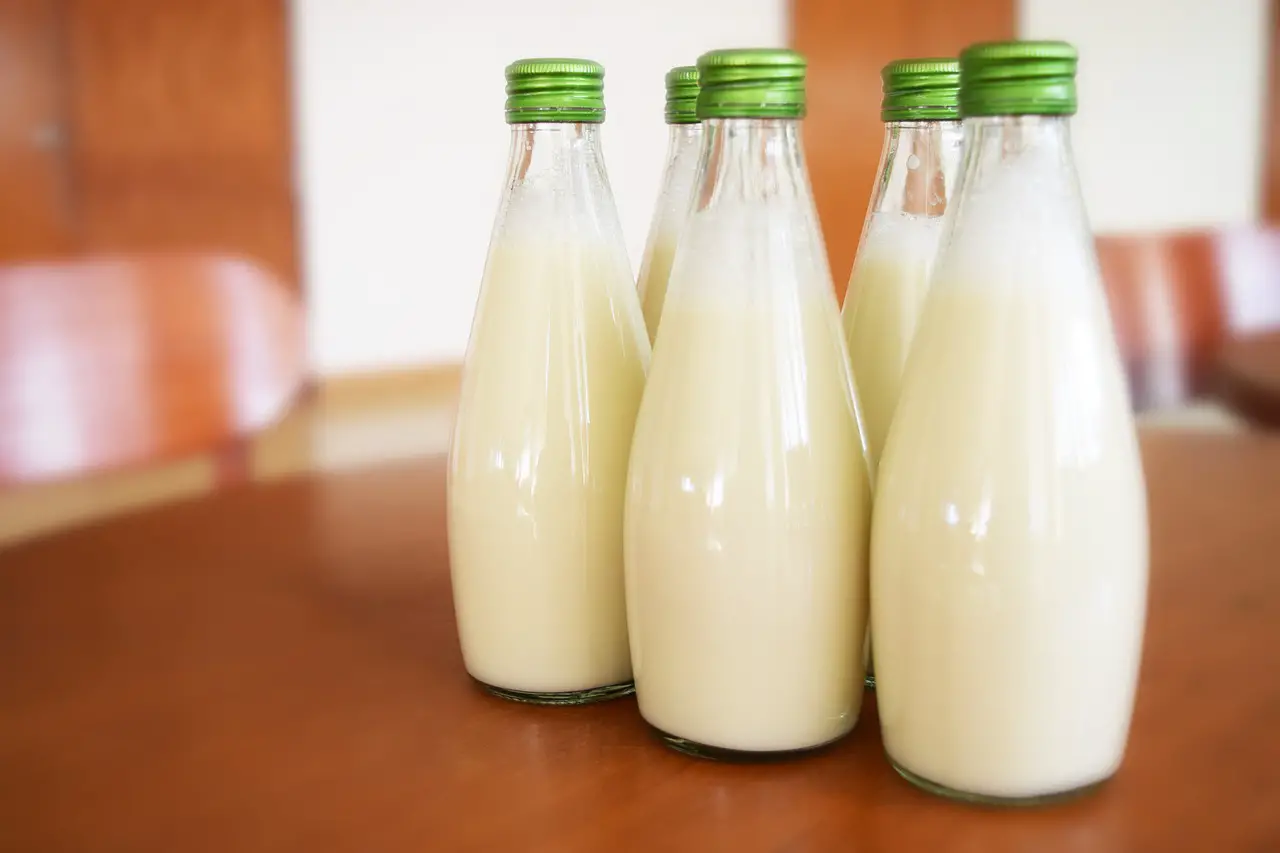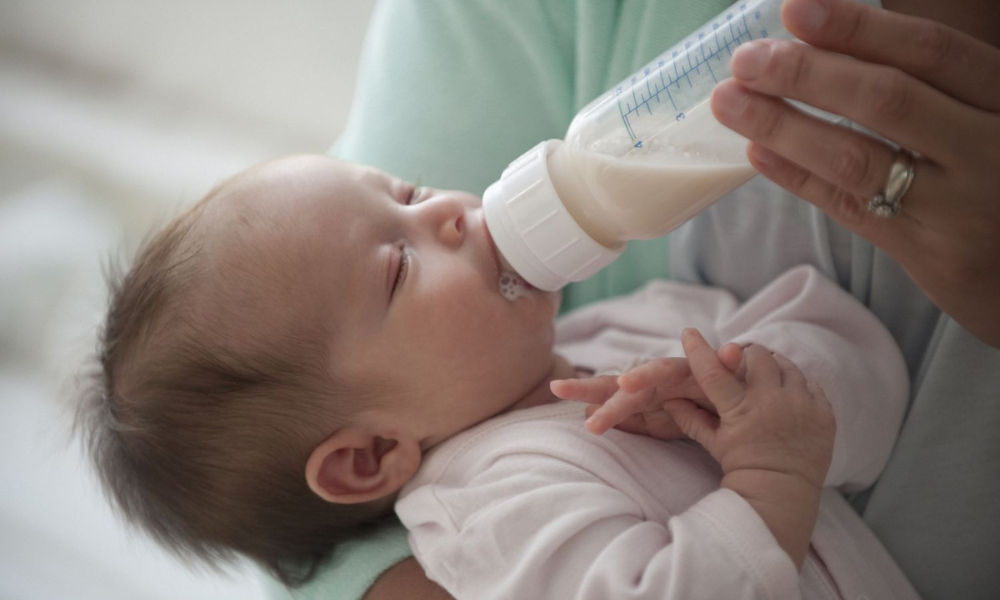One of the questions that many new parents ask is how long is breastmilk good out of the fridge? Fortunately, several factors determine how long breast milk is safe to consume. These factors include the type of container in which the milk is stored, whether it is cleaned, and how it is stored.
If you have decided to store breast milk, you may wonder how long it will last. Breast milk, like many other foods, can be frozen and stored. This allows you to save some for later use. However, you want to make sure that you follow proper storage guidelines. The first step is to get a suitable container for storing the milk. Ideally, you will want a glass container. You should also make sure that the container is BPA-free.

What is Breast Milk?
Breastmilk is the organic milk created by a woman’s breasts specifically for her unborn child. It serves as an infant’s main source of nutrition for the first six months of life and should be given in addition to solid foods until the child is at least 12 months old.
Water, fat, protein, carbs, and several vitamins and minerals are all present in breast milk. Additionally, it includes immune-stimulating elements like antibodies to help shield infants from illness and infection.
Breastmilk’s composition evolves throughout time to meet the baby’s changing needs. Colostrum, the milk produced in the first few days following birth, is rich in protein, antibodies, and other immune-stimulating compounds. Then comes transitional milk, which has a higher fat and calorie content than colostrum and is thicker and creamier to promote the baby’s growth. Finally, mature milk, which is thinner and easier for the baby to digest, is produced.
How Long is Breastmilk Good Out of the Fridge?
Various elements, including time and storage conditions, can impact breastmilk’s safety and quality. Breastmilk can be kept in the refrigerator for up to four days, according to the Centers for Disease Control and Prevention (CDC). To ensure the highest quality, it is advised to use it within three days. You can freeze it if you need to keep it longer. Breastmilk can be kept in a deep freezer for a year and the back of the freezer for up to six months.
Freshly expressed breastmilk may be stored at room temperature for up to 4 hours (up to 77°F or 25°C). Nevertheless, it is advised to utilize it or place it in the refrigerator or freezer as soon as possible after expressing.
It is significant to remember that breastmilk should not be refrozen after it has been defrosted; instead, it must be utilized within 24 hours. The breastmilk must also be properly labeled and date-stamped before being stored.
How to Store Breast Milk?
To maintain the safety and purity of breastmilk, it is crucial to store it properly. Here are some suggestions regarding milk storage:
- Before storing the breastmilk, please give it a label and a date.
- Breastmilk that has just been expressed can be kept in the fridge for up to four days. However, utilizing it within three days is advised to preserve the finest quality.
- Breastmilk can be kept in a deep freezer for a year and the back of the freezer for up to six months.
- Use heavy-duty, freezer-grade plastic bags, an insulated bag, a container made expressly for preserving breastmilk, or another option.
- Leave an inch of space at the top of containers when storing breastmilk in the fridge or freezer to allow for expansion of the milk while freezing.
- Breastmilk that has been thawed shouldn’t be refrozen and utilized immediately.
- Breastmilk shouldn’t be kept in the freezer or refrigerator door since the temperature can change.
- Avoid scorching breast milk when reheating it since it can destroy the antibodies and other immune-stimulating components. The best way to defrost frozen breastmilk is to leave it in the fridge overnight or run some water over it.
- You can bring a small insulated cooler bag with ice packs to store your breastmilk during transport if you’re away from your child for a brief time.
- Use a new container for each pumping, and avoid storing breastmilk alongside formula or other foods.
How to Properly Freeze Breast Milk?
When traveling or don’t have access to fresh milk, freezing breastmilk is a terrific way to keep its nutritional value and give your infant a convenient food source.
The following recommendations are for freezing breastmilk:
- Before freezing the breastmilk, label and date it.
- Use heavy-duty, freezer-grade plastic bags, an insulated bag, a container made expressly for preserving breastmilk, or another option. For the milk to expand as it freezes, leave an inch of room at the top of the container.
- Breastmilk can be kept in a deep freezer for a year and the back of the freezer for up to six months.
- Place the jar of frozen breastmilk in the fridge overnight or with warm water to thaw it. A microwave shouldn’t be used to melt breast milk since it can destroy the milk’s antibodies and other immune-stimulating components.
- Use breastmilk that has been defrosted within 24 hours; do not refreeze.
- Shake the container vigorously before using the frozen milk to re-distribute any cream that may have separated.
- Small amounts of breastmilk should not be frozen because they will take up more freezer space and almost always go to waste.
- To save waste, it is advisable to thaw and use the milk that is the oldest first.
- Avoid storing breastmilk in the door of the freezer as it can fluctuate in temperature.
- You can freeze breastmilk in tiny or big volumes depending on your needs and available milk.
What is the Correct Method of Thawing the Breast Milk?
It’s easy to thaw frozen breastmilk, but it’s crucial to do so safely to maintain the milk’s quality.
Overnight, put the breastmilk that has been frozen in the refrigerator. This method of thawing breastmilk is the safest and gentlest.
Following are some tips for defrosting frozen breastmilk:
- Place the frozen breastmilk in a bowl of warm water to quickly thaw it out if necessary. Avoid using hot water or a microwave to thaw the milk since high temperatures might harm the milk’s antibodies and other immune-stimulating components. Instead, make sure the water is not too hot.
- Shake the bottle vigorously after the breastmilk has frozen to spread any cream that might have separated.
- Use breastmilk that has been defrosted within 24 hours; do not refreeze.
- You can bring a small insulated cooler bag with ice packs to store your thawed breastmilk during transport if you’ll only be away from your child for a brief time.
- Breastmilk that has been thawed should be thrown out if it smells bad or looks discolored.
- To save waste, it is advisable to thaw and use the milk that is the oldest first.
- Avoid using the microwave to thaw or warm the milk since the heat might create hot spots that could burn your baby’s mouth.
- If you aren’t using the thawed milk right away, make sure to keep it correctly in the refrigerator.
- If you’re going to store, freeze, or defrost breastmilk, ensure that your bottles and containers are clean and adequately sanitized.
How to Identify Whether Breast Milk has Gone Bad?
Natural and perishable, breastmilk can spoil if not handled or kept appropriately. Here are a few indicators that your breastmilk may be damaged:
- Sour aroma: The aroma of fresh breast milk should be mild and sweet. The milk can be ruined if it smells bad or rotten.
- Color: Fresh breastmilk typically has a yellowish or bluish-white hue. Milk may be spoilt if it has clumps or is discolored.
- Look that is clumpy or thick: New breastmilk is often smooth and thin. The milk can be spoilt if it is lumpy or thick.
- Mold: If you notice mold on the surface of the milk, you should throw it away.
- A metallic or off-tasting taste indicates that the milk may be spoilt and should be thrown away.
Breastmilk can separate when stored; the cream may float to the top; this is normal and can be blended back in by shaking the container.
It’s crucial to handle carefully and store breastmilk to avoid spoiling, and thoroughly check the milk before giving it to your baby to ensure it’s safe for consumption. It is best to throw away milk if you think it may have gone bad or have any concerns about its freshness to prevent potential health risks.
What are the Health Risks of Consuming Spoiled Breast Milk?
Eating contaminated breast milk can result in food poisoning, which can cause symptoms like nausea, vomiting, pains in the stomach, diarrhea, and fever. Infections may also result from it, and if the substance is moldy, allergic reactions such as runny nose, itchy eyes, and sneezing may result.
Consuming contaminated breast milk increases the chance of contracting an illness, especially for young children and newborns whose immune systems are still developing. Salmonella, E. coli, and Staphylococcus aureus are a few of the bacteria that can flourish in tainted breast milk. The severe illnesses that these bacteria can produce include fever, vomiting, and diarrhea.
To avoid spoiling, handling and storing breast milk correctly is crucial. It is important to throw away milk if you think it may have gone bad or are unsure of its freshness to prevent any possible health problems. You should also thoroughly check the milk before giving it to your infant to ensure it’s safe for consumption. Consult a doctor immediately if your baby displays any sickness symptoms after drinking tainted breast milk.
Total mercury (THg) levels were determined by atomic fluorescence spectrometry after breast milk samples from 18 nursing moms were digested in nitric acid in a microwave between the 15th and 90th day of lactation. On the 74th and 76th day of lactation, participants replied to a 24-hour dietary recall questionnaire and a Food Frequency Questionnaire that inquired about their fish consumption in the previous 90 days. Using the PC-SIDE software, the average intake was calculated. On the seventy-fifth day of lactation, a fish supper was provided. During the study period, the mean THg levels of the mothers varied from 0.76 to 22.7 ng/mL, and the mean level for all samples (n = 142) was 6.47 6.04 ng/mL.
Conclusion
Breast milk should be stored in a clean and sterile container. It can be stored in a freezer, refrigerator, or room temperature. The CDC offers guidelines on breast milk storage.
To protect the nutritional content of your breast milk, it is best to store it in bottles or containers with tight-fitting lids. This helps to keep the ice and water from evaporating, which can further break down the milk components. If you plan to freeze breast milk, keep it in a hard plastic container with a snap-top. This container will hold the milk fresh for up to 12 months.
